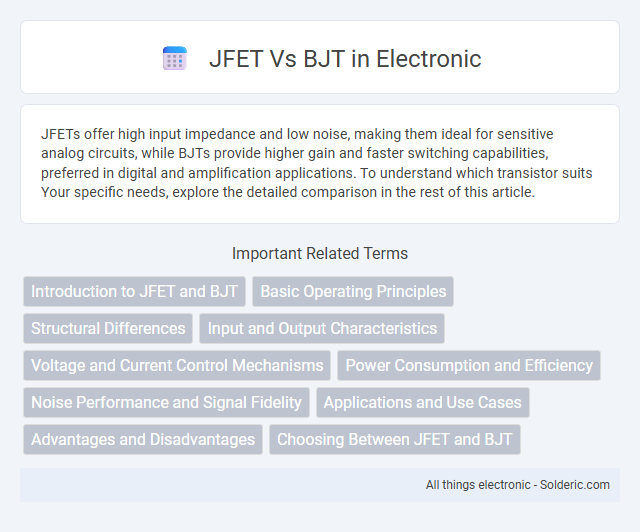JFETs offer high input impedance and low noise, making them ideal for sensitive analog circuits, while BJTs provide higher gain and faster switching capabilities, preferred in digital and amplification applications. To understand which transistor suits Your specific needs, explore the detailed comparison in the rest of this article.
Comparison Table
| Feature | JFET (Junction Field-Effect Transistor) | BJT (Bipolar Junction Transistor) |
|---|---|---|
| Type | Voltage-controlled device | Current-controlled device |
| Operation | Controls current through electric field | Controls current through charge injection |
| Input Impedance | High (10^9 O or higher) | Low to moderate (10^2 - 10^4 O) |
| Noise | Low noise, suitable for small signal amplification | Higher noise compared to JFET |
| Gain | Moderate voltage gain | High current and voltage gain |
| Switching Speed | Slower compared to BJT | Faster switching capability |
| Biasing | Simple, voltage bias | Complex, requires base current biasing |
| Linearity | Better linearity | Less linear compared to JFET |
| Thermal Stability | Good thermal stability | Lower thermal stability, prone to thermal runaway |
| Applications | Low-noise amplifiers, analog switches, voltage-controlled resistors | Amplifiers, switches, digital circuits |
Introduction to JFET and BJT
JFET (Junction Field Effect Transistor) and BJT (Bipolar Junction Transistor) are two fundamental types of transistors used in electronic circuits for amplification and switching. JFET operates as a voltage-controlled device where current flows through a semiconductor channel modulated by the gate voltage, offering high input impedance and low noise. BJT functions as a current-controlled device with three layers of semiconductor material and allows high gain and fast switching, making it ideal for signal amplification in analog circuits.
Basic Operating Principles
JFETs operate by controlling current through a semiconductor channel via a voltage applied to the gate, which modulates the depletion region and thus the channel conductivity, relying on majority carriers for conduction. BJTs function based on current injection, where a small base current controls a larger current flowing between the collector and emitter, utilizing both majority and minority carriers for amplification. The JFET's voltage-controlled operation contrasts with the BJT's current-controlled mechanism, influencing their respective switching and amplification characteristics.
Structural Differences
JFETs (Junction Field-Effect Transistors) feature a channel controlled by a reverse-biased p-n junction, allowing current flow through a semiconductor channel between source and drain terminals. BJTs (Bipolar Junction Transistors) consist of three layers of alternating p-type and n-type materials (emitter, base, and collector) that control current flow through charge carriers injected from the emitter to the collector. The JFET operates as a voltage-controlled device with high input impedance, while the BJT functions as a current-controlled device with lower input impedance due to its bipolar conduction mechanism.
Input and Output Characteristics
JFETs exhibit high input impedance due to their reverse-biased gate junction, making them ideal for voltage-sensitive applications, while BJTs have lower input impedance because of their forward-biased base-emitter junction. In output characteristics, BJTs operate with current control, providing high gain with a wide range of collector currents, whereas JFETs function as voltage-controlled devices with saturation regions defined by drain current and voltage. Your choice between JFET and BJT depends on factors like input impedance requirements and linearity in amplification tasks.
Voltage and Current Control Mechanisms
JFETs operate through voltage-controlled mechanisms where the gate-to-source voltage regulates the current flow by modulating the channel conductivity, offering high input impedance and low noise. BJTs use current-controlled mechanisms, relying on the base current to control the collector-emitter current, providing high current gain but lower input impedance. These fundamental differences make JFETs suitable for low-noise amplifiers and BJTs ideal for applications requiring high current amplification.
Power Consumption and Efficiency
JFETs generally consume less power than BJTs because they operate with voltage-controlled channel resistance rather than current-controlled junctions, resulting in lower quiescent currents. BJTs require continuous base current to maintain conduction, increasing power dissipation and reducing efficiency in low-power applications. The high input impedance and low leakage current of JFETs make them more efficient for low-power and high-frequency circuits compared to BJTs.
Noise Performance and Signal Fidelity
JFETs exhibit lower noise levels and higher signal fidelity compared to BJTs due to their majority carrier operation, which reduces flicker and thermal noise. BJTs, while offering higher gain, generate more noise because of minority carrier injection and complex charge storage effects. For your sensitive analog applications, selecting a JFET can significantly improve noise performance and preserve signal integrity.
Applications and Use Cases
JFETs excel in low-noise signal amplification and analog switching due to their high input impedance and low power consumption, making them ideal for precision measurement instruments and audio equipment. BJTs dominate in high-frequency and high-gain applications such as RF amplifiers, power regulation circuits, and digital switching devices because of their higher current density and fast switching capabilities. Both components are crucial in analog circuit design, with JFETs favored for voltage-controlled resistors and BJTs preferred in applications requiring high current drive and rapid response.
Advantages and Disadvantages
JFETs offer high input impedance and low noise, making them ideal for sensitive analog circuits, but they suffer from lower gain and limited thermal stability compared to BJTs. BJTs provide higher gain and better switching speed, suitable for amplification and digital circuits, yet they require more input current and have lower input impedance. Your choice depends on whether you prioritize low input current and noise (JFET) or high gain and fast switching (BJT).
Choosing Between JFET and BJT
Choosing between a JFET and a BJT depends on factors such as input impedance, switching speed, and thermal stability. JFETs offer high input impedance and low noise, making them ideal for sensitive analog circuits, while BJTs provide higher current gain and faster switching suitable for digital and high-frequency applications. Your selection should align with the specific requirements of your circuit, including power consumption and signal amplification needs.
JFET vs BJT Infographic

 solderic.com
solderic.com